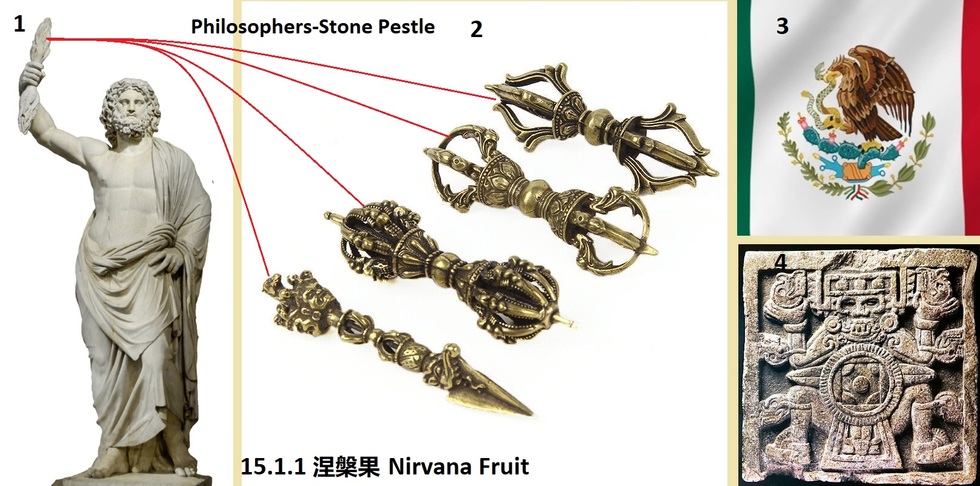

| 送交者: Adam_Luyan[♂☆★★声望品衔11★★☆♂] 于 2024-01-25 23:47 已读 30057 次 1 赞 | Adam_Luyan的个人频道 |
梵语涅槃义为圆满的寂静,是苦或烦恼全部被消灭后的身心清净状态,故亦名无所有。玄奘法师和弟子窥基在《成唯识论》中从四个方面谈涅槃,无余依涅槃,有余依涅槃,自性涅槃,和无住涅槃。
Nirvana in Sanskrit means perfectly fulfilled silence, which is the quiet state of body and heart after all bitterness or troubles have been eliminated, so it is also called Empty After All. Tang Tripitaka (aka. Tang Buddha) and his disciple Kuiji discussed Nirvana from four aspects in Establishing Sense-Only Treatise: Nirvana without Residual Dependence, Nirvana with Residual Dependence, Self-Nature Nirvana, and Non-Dwell Nirvana. 6park.com一)无余依涅槃,玄奘说: “真如出生死苦,烦恼既尽,余依亦灭,众苦永寂,故名涅槃。” 真如即七真如,参见11.6.4节《离系果》。余依,即依之而灭苦的依靠,是依善灭恶的善。余依亦灭,是说善恶两灭。
1) Nirvana without Residual Dependence, Tang Tripitaka said, “by True Suchness, migrator has ousted bitter of birth and death, the annoyances are exhausted, and the residual dependence is extinguished also, crowds of bitter are forever silent, therefore, the nirvana is named.” The True Suchness is the seven true suchness in the section 11.6.4 Off-is Fruit. The residual dependence, i.e., the reliance by which bitter is extinguished, is the benevolence by which ferocity is extinguished. That the residual dependence is also extinguished, means that both benevolence and ferocity are extinguished. 6park.com二)有余依涅槃,玄奘说: “真如出烦恼障,虽有微苦,所依未灭,而障永寂,故名涅槃。” 障是指异生性的所知障和烦恼障(参见11.4.4.2-4节的异生性)。此说择灭无为法,即有选择地消灭了某些根本烦恼,如下文中四种离系果中的前三果,和道谛菩萨十地中的前七地都是选择性地消灭了主要的烦恼障,所处的境界都是不同程度的有余依涅槃。
2) Nirvana with Residual Dependence, Tang Tripitaka said, “with True Suchness, migrator has ousted annoyance hindrances, although there is slight bitter, the residual dependence is not terminated, but the hindrances are silent permanently, so it is called Nirvana." Hindrances mean the Know Hindrance and Mean Hindrance of Mutant Nature (see section 11.4.4.2-4 Mutant Nature). This is saying Selectively Termination None-as Laws, such as the first three of the four Off-is Fruits in section 15.2, and the first seven of the ten lands in Path Crux, all are the sates of choosing fundamental annoyances to eliminate, they achieve varying degrees of nirvana. 6park.com三)自性涅槃,玄奘说:本来自性清淨涅槃,谓一切法相真如理,虽有客染而本性淨,具无数量微妙功德,无生无灭湛若虚空,一切有情平等共有,与一切法不一不异,离一切相、一切分别(注1),寻思路绝,名言道断(注2),唯真圣者自内所证,其性本寂故名涅槃。
3) Self-Nature Nirvana, Tang Tripitaka said: “The original quiet self-nature is Nirvana, which is all true suchness of juristic phenomena. Although it is contaminated by guest dusts, its original nature is immaculate, with countless delicate wonderful fortunes and virtues, no birth, no death, and as clear as space, shared equally by all sentient beings, not one and no differences from all laws, free from all phenomena and discriminations (Annotation 1). If you search or mean on it, the road ends, if you call its name or utter words, the path (Annotation 2) is broken. Only the true sage can prove it from within, its nature is inherently silent, hence Nirvana.
6park.com注1,涅槃即是微妙本心,是心之常。当人不分别所对的环境,心就停住了,就是涅槃。图16.1.1-1宙斯手中的就是金刚杵。如图2所示,是把法的四分(参见11.1节)折合成了两分,一端是名,包括受蕴、想蕴、行蕴、和识蕴;另一端是色蕴。当名和色相结合,一切法就出现了;当名色分离,就什么都没有了,就是涅槃,所以玄奘说 “寻思路绝,名言道断” ,因为你一寻思,一说话,心就已经又开始工作了,开始分别造作了,根尘就又结合了。
Annotation 1: Nirvana is the delicate wonderful original heart, which is constant of heart. When a person does not differentiate his or her environment, heart stops, which is nirvana. Figure 16.1.1-1 The Philosophers-Stone Pestle is in the hand of Zeus. As shown in Figure 2, the four Juristic Quadrants (see Section 11.1) are folded into two parts. One end is Name, including Acceptance Node, Think Node, Migration node, and Sense Node; another end represents Color Node. When Name and Color are attached, all laws appear; when Name and Color are detached, there is nothing, which is Nirvana. That’s why Tang Tripitaka said, “if you mean and search, the road ends, as soon as you call its name or utter a few words, the path is destroyed”, because once you think or speak, the heart already started to distinguish and create again, the roots and dust are combined again. 6park.com注2,道谛讲的道理和行为都是根据涅槃的性质而设立出来的,故说涅槃即是道。那这涅槃是存在的,有的,为什么说涅盘是毕竟空?因为涅槃与空相应,不与有相合,无为法因此而设立。无为法(参见11.6.4节)的无字义即涅槃。一切有为法都与涅槃相违背。什么是有为法?基于塞斯(即转移身见),基于有的法都是有为法,例如目前的欧洲文化都是有为法,没有无为法;再如东方文化的深层都是无为法,有为法很少。
Annotation 2, the principles, and behaviors taught in Path Crux (see chapter 16) are all established based on Nirvana, so Nirvana is Path. Then this Nirvana exists, and have, why is it said that Nirvana is Empty After-all? Because Nirvana corresponds to emptiness and it is not combinable with haves, therefore None-as Law (see section 11.6.4) is established. The word None of None-as represents Nirvana. All Have-as Laws contradict Nirvana. What is Have-as Law? Laws based on Seth (i.e., translocation body view) and haves are Have-as Laws. For example, the current European cultures are all have-as laws, and there is no non-as law; on the opposite, the deep layers of eastern cultures are all non-as Laws and have-as laws are very few. 6park.com四)无住涅槃,玄奘说:真如出所知障,大悲般若常所辅翼,由斯不住生死涅槃,利乐有情穷未来际,用而常寂故名涅槃。此涅槃是说此人由于常用集起(参见14.1节)智,所以在他或她的前意识中形成了一个集起的空集∅,就是无住涅槃。如图15.1.1-4是卡特莉的雕像,她的胸中有个太阳,代表她已经成就了 “无住涅槃” 。因为她是夏娃,是前意识的化身,所以古墨西哥人就把这个太阳画到她的胸腹里了。插图3中墨西哥国旗上的鹰就代表着卡特莉,她就是后来的般若(即到达方舟)的作者。
4) Non-Dwell Nirvana, Tang Tripitaka said: “by true suchness, migrator has ousted Know Hindrance, assisted by Great Sorrowfulness and Arrival Ark constantly, therefore he or she does not dwell in nirvana, benefits and pleases sentient beings to the exhaustion of future, usage but constantly silent, hence name of nirvana”. This nirvana means that because the person often uses Aggregate Arousal (see section 14.1) intelligence, therefore there is empty sets ∅ of Aggregate Arousal is formed in his or her preconsciousness, which is the Non-Dwell Nirvana. Figure 15.1.1-4 is a statue of Tlaltecuhtli with a sun in her chest, which means that she has achieved the Non-Dwell Nirvana. Because she is Eve, the incarnation of preconsciousness, so the ancient Mexicans painted the sun (the fourth sun in their legends) into her chest. The eagle on the Mexican flag in Illustration 3 represents Tlaltecuhtli, who is the author of Arrival Ark later. 6park.com什么是大悲?以此墨西哥传说的《第五个太阳》(参见第18章)为例,墨西哥的后半生都没能从他神父舍利王(即上帝)的死中恢复过来,常常哭泣;这就是大悲。悲是慈悲喜舍四无量心之一,所以墨西哥(即亚当)力量的主要来源就是他对上帝为拯救人类和众生而牺牲的悲伤。
What is the Great Sorrowfulness? Take the Mexican legend "The Fifth Sun" (see Chapter 18) as an example. Mexico was unable to recover from the death of his godfather Huitzilopochtli (i.e., God) for the rest of his life and often cried, which is Great Sorrowfulness. Sorrowfulness is one of the four Infinite Hearts of Mercifulness, Sorrowfulness, Delight, and Renunciation, so the main source of strength for Mexico (i.e. Adam) is his sorrow for the sacrifice of God to save mankind and all living beings. 6park.com↪️返回第15章《灭谛》目录-https://web.6parkbbs.com/index.php?act=view&tid=3408347

